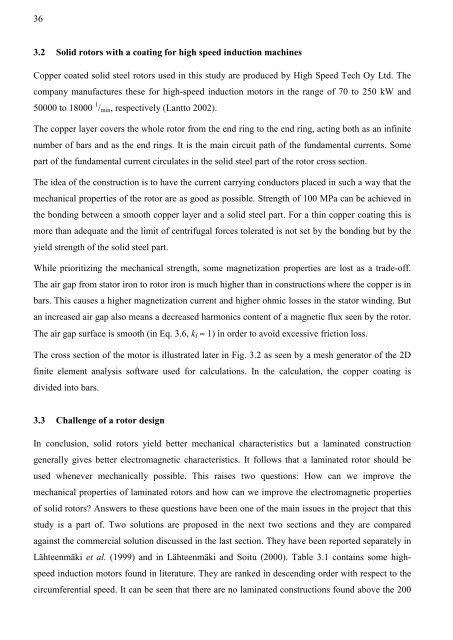Design and Voltage Supply of High-Speed Induction - Aaltodoc
Design and Voltage Supply of High-Speed Induction - Aaltodoc
Design and Voltage Supply of High-Speed Induction - Aaltodoc
You also want an ePaper? Increase the reach of your titles
YUMPU automatically turns print PDFs into web optimized ePapers that Google loves.
36<br />
3.2 Solid rotors with a coating for high speed induction machines<br />
Copper coated solid steel rotors used in this study are produced by <strong>High</strong> <strong>Speed</strong> Tech Oy Ltd. The<br />
company manufactures these for high-speed induction motors in the range <strong>of</strong> 70 to 250 kW <strong>and</strong><br />
50000 to 18000 1 /min, respectively (Lantto 2002).<br />
The copper layer covers the whole rotor from the end ring to the end ring, acting both as an infinite<br />
number <strong>of</strong> bars <strong>and</strong> as the end rings. It is the main circuit path <strong>of</strong> the fundamental currents. Some<br />
part <strong>of</strong> the fundamental current circulates in the solid steel part <strong>of</strong> the rotor cross section.<br />
The idea <strong>of</strong> the construction is to have the current carrying conductors placed in such a way that the<br />
mechanical properties <strong>of</strong> the rotor are as good as possible. Strength <strong>of</strong> 100 MPa can be achieved in<br />
the bonding between a smooth copper layer <strong>and</strong> a solid steel part. For a thin copper coating this is<br />
more than adequate <strong>and</strong> the limit <strong>of</strong> centrifugal forces tolerated is not set by the bonding but by the<br />
yield strength <strong>of</strong> the solid steel part.<br />
While prioritizing the mechanical strength, some magnetization properties are lost as a trade-<strong>of</strong>f.<br />
The air gap from stator iron to rotor iron is much higher than in constructions where the copper is in<br />
bars. This causes a higher magnetization current <strong>and</strong> higher ohmic losses in the stator winding. But<br />
an increased air gap also means a decreased harmonics content <strong>of</strong> a magnetic flux seen by the rotor.<br />
The air gap surface is smooth (in Eq. 3.6, kf ≈ 1) in order to avoid excessive friction loss.<br />
The cross section <strong>of</strong> the motor is illustrated later in Fig. 3.2 as seen by a mesh generator <strong>of</strong> the 2D<br />
finite element analysis s<strong>of</strong>tware used for calculations. In the calculation, the copper coating is<br />
divided into bars.<br />
3.3 Challenge <strong>of</strong> a rotor design<br />
In conclusion, solid rotors yield better mechanical characteristics but a laminated construction<br />
generally gives better electromagnetic characteristics. It follows that a laminated rotor should be<br />
used whenever mechanically possible. This raises two questions: How can we improve the<br />
mechanical properties <strong>of</strong> laminated rotors <strong>and</strong> how can we improve the electromagnetic properties<br />
<strong>of</strong> solid rotors? Answers to these questions have been one <strong>of</strong> the main issues in the project that this<br />
study is a part <strong>of</strong>. Two solutions are proposed in the next two sections <strong>and</strong> they are compared<br />
against the commercial solution discussed in the last section. They have been reported separately in<br />
Lähteenmäki et al. (1999) <strong>and</strong> in Lähteenmäki <strong>and</strong> Soitu (2000). Table 3.1 contains some highspeed<br />
induction motors found in literature. They are ranked in descending order with respect to the<br />
circumferential speed. It can be seen that there are no laminated constructions found above the 200
















